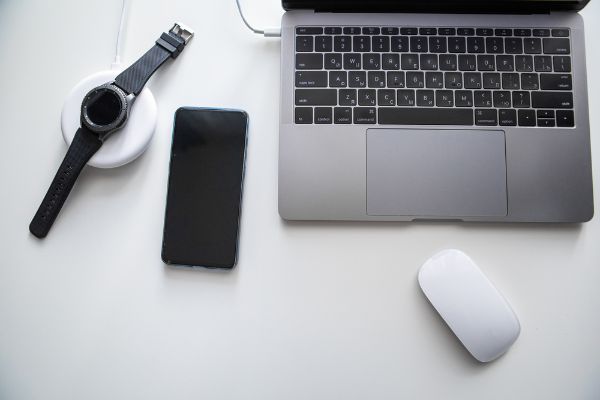Disclaimer: This post may contain affiliate links, meaning we get a small commission if you make a purchase through our links, at no cost to you. For more information, please visit our Disclaimer Page.
The MacBook is a line of laptop computers that Apple has produced for many years. Although it has gone through a few iterations, the current setup includes the MacBook Air and Pro models. Users can think of the MacBook Pro as the higher-end version of the laptop, while the MacBook Air is aimed at the average consumer. However, both models offer some great features for both business and entertainment purposes.
Some people who own MacBooks wonder if it is okay to leave them plugged into a power source at all times, in contrast to using the battery that comes with the device sometimes. We will try to look at this question from a few angles in our article below.
Additionally, we will focus on any possible negatives that users might experience just from leaving the computer plugged in, either all the time or most of the time, and whether it might be a good idea to power down the device fully on occasion.
If you find that your MacBook seems to shut itself off almost immediately once you unplug it, we will try to suggest some ways you can troubleshoot that issue, too.
Table of Contents
Should I Keep My MacBook Always Plugged In?
MacBooks are a version of portable laptop computers, so it makes sense that many users would want to use them while they are away from home for part of the day. Depending on how the battery life is optimized or what you need to do, you may find that a single charge from a relatively new MacBook could serve you for a few days.
Although laptop form factors are designed for use away from a main power source, some people do like to use them as semi-permanent replacements for desktop rigs. Most laptops do not have the same specifications as your typical desktop, but they are still quite capable computing machines. If you already have something like a MacBook, it may make little sense to you to get a second computer just to have a true desktop.
In these situations, you might wonder if you can just leave the unit plugged into the wall outlet continuously. After all, you’re usually not moving the laptop anywhere, and it probably doesn’t sound sensible to use the battery power for no reason.
You may wish to save it for times when your own power at home is not working. If you notice your battery bar at all, it should display that it is at its full charge any time you hover the mouse over it. In rare cases, it may say that it is plugged in and charging up to its full potential, and you may notice a few percentage points temporarily missing from the battery’s readout.
The truth is, older batteries or laptop models may have had some problems with battery life if they were plugged in all the time.
Nowadays, modern laptops and their batteries can almost always handle regulating themselves in ways that allow them to stay plugged in indefinitely. There may be a few caveats to this guideline, but it is usually okay to just leave your MacBook plugged in.
Is It Bad To Keep a MacBook on All the Time?
Generally, it is not bad to keep the MacBook plugged in continuously as you are using it at home or anywhere near a power source. In most use cases, it should be fine for both the device and its battery. However, that doesn’t mean that there might not be some caveats of which you should be aware.
For example, it is possible that, if you leave the computer plugged in all day, every day, for many months at a time, that the overall charge could be diminished. This means that the amount of power or time that the battery can give to the MacBook before it gets to zero and needs a recharge might be reduced from what it was when the component was new.
This can be a difficult thing to determine, particularly since all batteries eventually lose some of their charge over long periods of time. Because every battery will lose a bit of this percentage as the years go by, you may have some problems in deciding if keeping the MacBook plugged in all the time contributed to this in any way.
It is usually a good idea to let new batteries discharge to quite a low percentage before charging them back up again or plugging them in.
Doing this lets them use some of their energy, and it is also a good way for you to gauge how long a typical charge will last. If you notice any huge discrepancies after some weeks or months of being plugged in, it could be from not using the battery in a long time.
However, it is important to keep in mind that most modern batteries do not overcharge. In the past, overcharging could affect the life and health of the battery. Leaving something on a battery plugged in all the time could cause it to charge beyond its maximum, although you would not notice this just by looking at the battery life gauge.
Doing this would cause problems with the battery retaining energy when you unplugged the device from the main power source.
Modern batteries have protections against overcharging. Once they reach their full capacities, they should shut off the charging process automatically. This is true even if the device they run is plugged into the wall. Furthermore, your battery should use a bit of its energy from time to time, then charge itself back up to its full potential.
Older batteries may have had some issues with swelling inside the case when they were plugged in all the time, too. In the past, it may have been more beneficial to run the computers off of their batteries from time to time. However, such batteries could swell even with this practice in place, too.
Fortunately, Apple technicians seemed to have solved this problem several years ago. While defects or errors can still happen, most users should not experience something like battery swelling in their MacBooks.
Apple’s laptops use lithium-ion batteries. In general, it may not be good for these batteries to be at their full charge all the time. Although these kinds of batteries are great for modern computing systems, it might be a good idea to cycle the battery from its full charge down to at least half from time to time. Part of the reason for this is that batteries of this type might overheat while charging quite easily.
However, they are also designed to slow the charging process as they near their full capacities in order to prevent this. Still, it isn’t a bad idea to run your MacBook from the battery on occasion.
How Often Should I Shut My MacBook Off?
There is no hard rule for how often you should turn off your MacBook. This is different from just putting it to sleep, a process which uses minimal processes and energy to help you conserve power while still picking up where you left off. In most cases, you should be able to just use the sleep function and get by just fine.
However, many processes keep running in the background of these frozen sessions when you start them up again. Memory can also get a bit clogged. Sometimes, the only way to deal with these kinds of things is to give the MacBook a clean slate, and shutting it down completely can do this.
If you notice that your MacBook is running a bit slowly, or if programs are failing to load at all, it may be a good idea to shut down the laptop completely and give it a restart. Should you find that you’ll be away from the device for more than a single night, it might be a good opportunity to do the same thing.
How Come My MacBook Turns Off When the Charger Is Unplugged?
There are only a couple of reasons why the MacBook turns off if you unplug the charger. If your laptop is new, it is possible that the battery was defective from the start and not holding a charge. Although this is rare, it can happen.
You can use the computer’s system settings to check this data, and there are several free or paid apps that will monitor the battery’s health, too.
If your computer has some years on it, you should still check the battery life output to see what percentage of the full charge you are getting.
If neither of these things shows any abnormalities, you might need to do an SMC reset.
What Are Some Ways To Fix This?
If the battery is defective on a new laptop still under warranty, you can request a replacement or repair from Apple. For an SMC reset, you can do the following steps:
- Make sure the MacBook is plugged into the power adapter.
- Shut it down completely as you normally would.
- Once done, press the left ‘Shift’, ‘Control’, and ‘Option’ keys along with the power button all at the same time.
- Release these keys simultaneously.
- Turn the MacBook computer on again to see if the battery life is restored.
If the battery truly is dead, you can install a recommended replacement that works with your laptop.
Conclusion
For the most part, you shouldn’t have any issues using the laptop as a stationary desktop and leaving it plugged in all the time. It may be a good idea to let the MacBook cycle its battery partially from time to time. This could help with overall battery longevity. If your MacBook can’t turn on when it is unplugged, you can use some of our troubleshooting tips to diagnose the issue.


